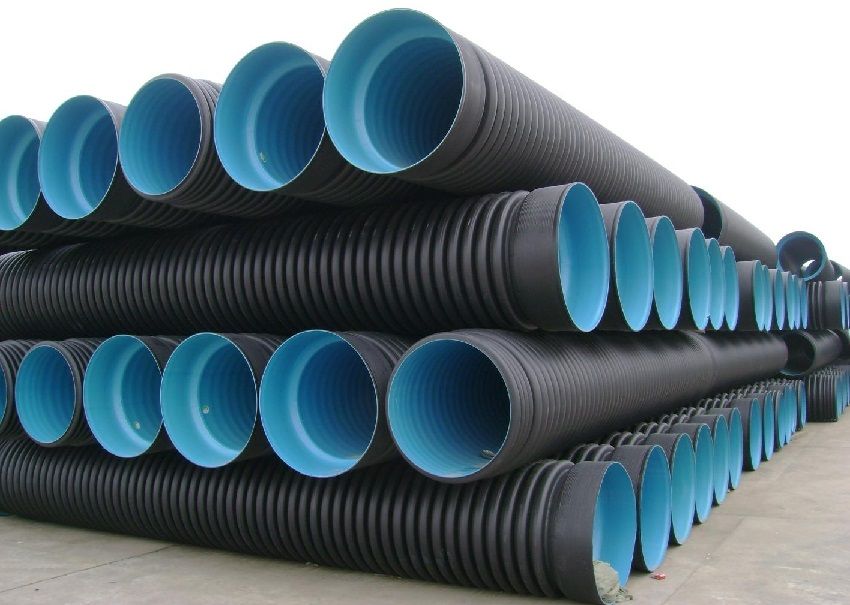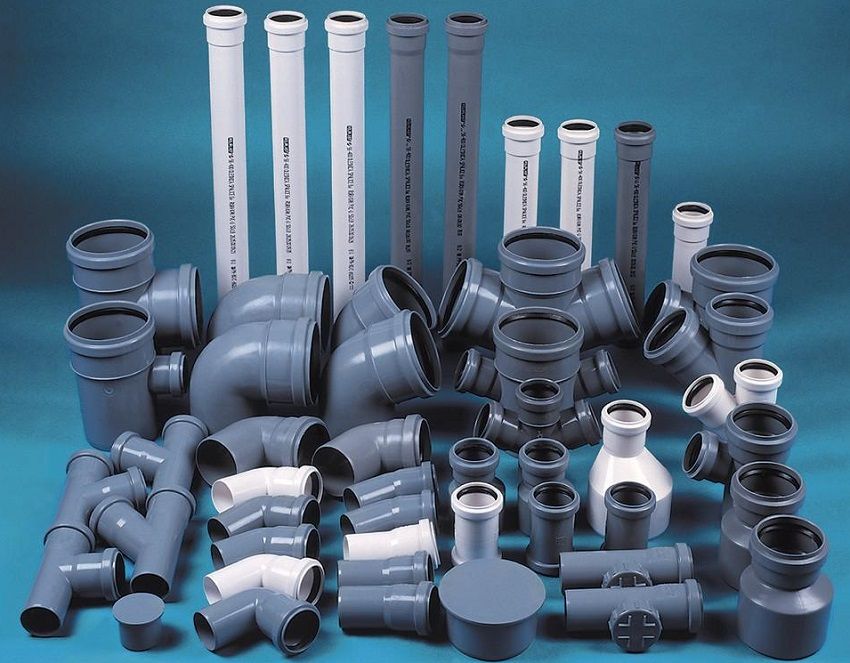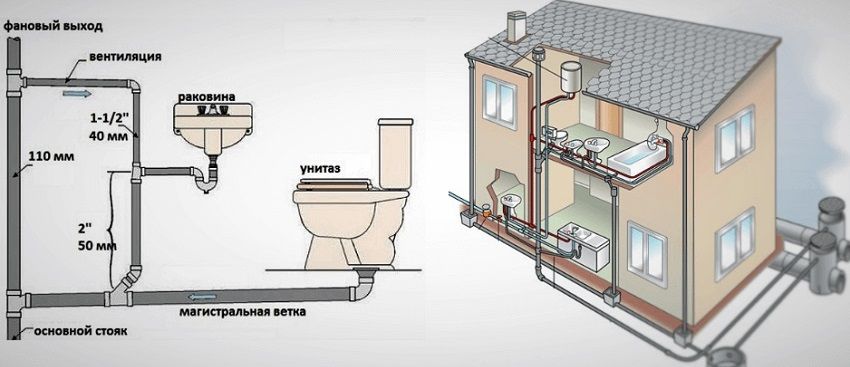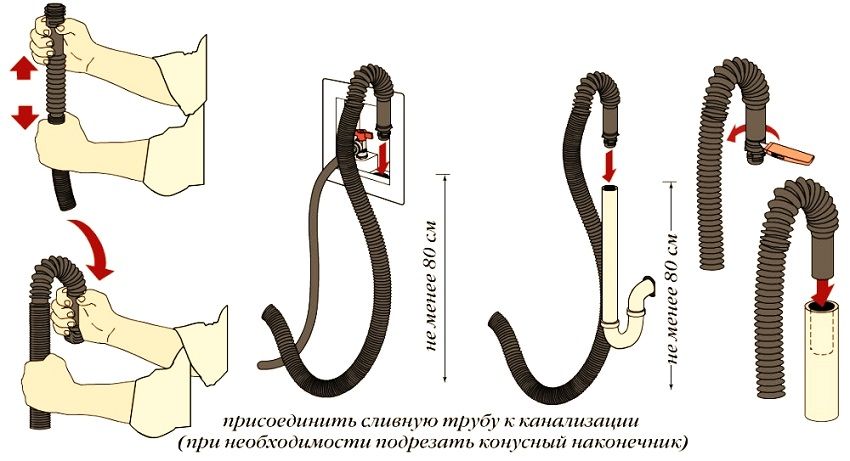From this article, you can find out the features of such an element of communications as a sewer drain pipe: its purpose, types of existing products that can be purchased in stores, their characteristics and prices. The text describes the specifics of the discharge and recommendations for the installation of the riser sewer system, including instructions for dismantling the old pipeline.

Sewage drain pipe: features of existing products
Sewerage is one of the most important communication systems related to housing water supply. For this reason, it is very important to pay particular attention to the choice of components, their quality, in particular, the drain pipes.
Drain pipes are used for installation of sewer communication system. Manufacturers offer a wide range of these products, differing from each other in material, functional characteristics and purpose.

Classification of existing drain pipes on the material of manufacture:
- asbestos;
- copper;
- cast iron;
- plastic;
- reinforced concrete;
- steel;
- ceramic.
By appointment, all these products are divided into two categories. External pipes are laid outside the premises, while internal pipes are designed for the installation of plumbing and sanitary in the room.

Outdoor sewage systems are mounted outside the building or in the soil adjacent to it. Since their operation is carried out in outdoor conditions, such products should have improved properties:
- high strength;
- frost resistance;
- resistance to deformation changes;
- resilience to the influence of aggressive media;
- resistance to high pressure on the walls.
Note! For the organization of an external drain system, it is better to take products made from materials with high corrosion resistance. These include painted metal, polymers and galvanized steel.

The most popular for domestic sewage pipes are made of polymers. They have many advantages:
- affordable price;
- long service life;
- simple installation system of internal sewage;
- corrosion resistance;
- low thermal conductivity;
- resistance to alkaline and chemical substances;
- extensive range of sizes and shapes;
- small weight;
- security.

For the manufacture of plastic pipes used various polymeric substances. This category of products includes elements of polyethylene (corrugated and smooth), polypropylene and low pressure polyethylene. To determine which ones are best suited for installing a sewer riser, you should familiarize yourself with the features of each type of pipe.
Features of plastic pipes:
| Material type | Benefits |
| Polyethylene (rigid pipes) | chemical resistance |
| possibility of trenchless mounting | |
| increased strength nodal joints | |
| Polyethylene (corrugated pipe) | high flexibility |
| possibility of mounting at a depth of up to 20 m due to enhanced ring stiffness | |
| Polypropylene | affordable price |
| high reliability | |
| simple installation system | |
| possibility of quick dismantling | |
| HDPE (low pressure polyethylene pipes) | high resistance to mechanical damage |
| resistance to the negative influence of environmental factors |
If a pipe is required to drain the bathroom, then the use of rigid or corrugated products made of polypropylene will be appropriate. The recommended pipe diameter in this case is 40 mm. The cost of such an element varies from 50 to 120 rubles. depending on the length. If the room does not have a free area, you can confine one knee. In the large bathroom can accommodate two knees.
For the organization of the drain under the toilet, it is better to buy a PVC pipe for sewage, the price of corrugated products with a diameter of 110 mm is about 300 rubles. Due to the increased flexibility, the system can be customized to fit any model of the toilet bowl and convenient to attach it.

Helpful advice! Experts advise to pick up pipes with thick walls. Such products will last longer before rubbing.
For arranging the drain from the sink to the sewer most often used corrugated products. It is allowed to use diameters of 40 mm, 32 mm, and in some cases this figure can reach 50 mm. It depends on the modification of the sink and siphon. The price of such products is in the range from 250 to 400 rubles.
Standard internal diameter sizing system:
| Size of internal diameter, mm | Scope of pipes |
| 5-10 | the drain element used to supply plumbing to a common system |
| 10-11 | details of plums and risers |
| 11-15 | elements of risers in high-rise buildings |
| more than 15 | connecting parts between internal and general sewage systems |
To connect the drain of the washing machine to the sewage, a special hose of corrugated material is used, which is present in the standard configuration of this equipment. The connection is carried out through a siphon, and for these purposes you can use the fork located under the sink.
External drain pipes are also used to drain sediment from the roof to the sewer system. For these purposes it is recommended to take products with rigid walls. The optimal material is polypropylene and HDPE. The diameter of the elements is selected based on the size of the building.
Size of products for removal of precipitation from the roof:
| Building size | Recommended diameter size, mm | |
| Channel | Gutter | |
| Small construction | 50-70 | 79-115 |
| Medium size construction | 75-100 | 115-130 |
| Large building | 90-160 | 140-200 |
Most often in residential buildings used products with a diameter of 110, 160 and 200 mm. The thickness of the walls of such pipes is 3.2 mm.
The price of sewer pipes 160, 110 and 200 mm:
| Product diameter, mm | Product length, m | price, rub. |
| 110 | one | 210 |
| 2 | 302 | |
| 3 | 428 | |
| 160 | one | 296 |
| 2 | 552 | |
| 3 | 785 | |
| 200 | one | 525 |
| 2 | 1020 | |
| 3 | 1530 |
Connecting the washing machine to the domestic sewage system and water supply can be done independently. This procedure should be approached responsibly, because the result depends on whether the equipment will work properly and without interruptions.
Connection of the washing machine in itself does not cause difficulties. Difficulties appear during the organization of the drain. If the procedure is performed incorrectly, in the room where the equipment is installed, there may be an unpleasant smell. In addition, there is a risk of contamination of the machine with water coming from other plumbing fixtures.
Helpful advice! For cutting metal elements of the pipeline is better to pick up a hacksaw with small teeth. This tool allows you to minimize the likelihood of chipping. The smaller the teeth, the more accurate and smoother the cuts are.

Ways to organize the drain:
- By installing a special siphon.
- Through direct installation of the hose in the sewer system.
- Throwing Shlag over the edge of the bath or washbasin.
The third method can be classified as temporary measures. In this case, you will not need to work with pipes and install a siphon, but further operation of the bathroom or sink will be accompanied by certain inconveniences. Waste water from the machine will leave traces of dirt on the floor. In addition, the method of fixing the hose is not very reliable, which is fraught with flooding. Hose breakage occurs during the spinning of the laundry due to strong vibration or when the pump is turned on to drain.

In the plumbing market, you can purchase special purpose siphons for sinks, bathtubs and sinks. They have an additional outlet for connecting a hose with a diameter of 22 mm. The process of connecting with a siphon is not complicated, in contrast to organizing the washing machine directly to the sewer. The fact is that pipes with a diameter of 32 or 50 mm are used for the general sewage system. At the same time there is no adapter capable of combining them with a 22-millimeter hose.
To connect in this case, you should use a rubber reduction having an adapter for a 22 mm hose. If the washing machine is located in the immediate vicinity of the common pipeline with a diameter of 50 mm, you can crash into the system with the help of a tee.
If the equipment is far away, a PVC pipe with a diameter of 32 mm can be drawn between the hose and the outlet. To connect the PVC product with the overall system will also require the use of rubber reduction. At the same time it will not be necessary to place the plastic pipe under an inclination, since in this case water will be drained by force.

Note! In some washing machines, a hose designed for draining may have different diameters at the ends. From the side of the unit its size is 19 mm. The diameter of the end that connects directly to the pipeline is 22 mm. This nuance should be considered during operation.
Before work, you need to make sure that there is a check valve on the drain of the machine that is able to pass water only in one direction. If not, the height level for placing the loop of the hose should be seen in the information from the manufacturer. In this place you need to create a water seal so that unpleasant odors from the drain pipe do not enter the room through the machine.
Most modern automatic washing machines have a backflow valve, so there should be no problems with connecting the hose. You only need to correctly connect the end smooth pipe and rubber reduction. In some cases, fixation to an additional siphon outlet is performed. In order to prevent damage to the rubber reduction, before packing it in a socket, it should be greased with a liquid detergent. Thus, the element will be easier to install in a smooth pipe.

If an additional siphon outlet is used for the connection, it will be sufficient to remove the factory pipe and in its place install the pipe from the hose. A special coupling is used to ensure sealing. It will seal the junction. The factory pipe in the siphon is intended only to preserve the performance of the elements.

